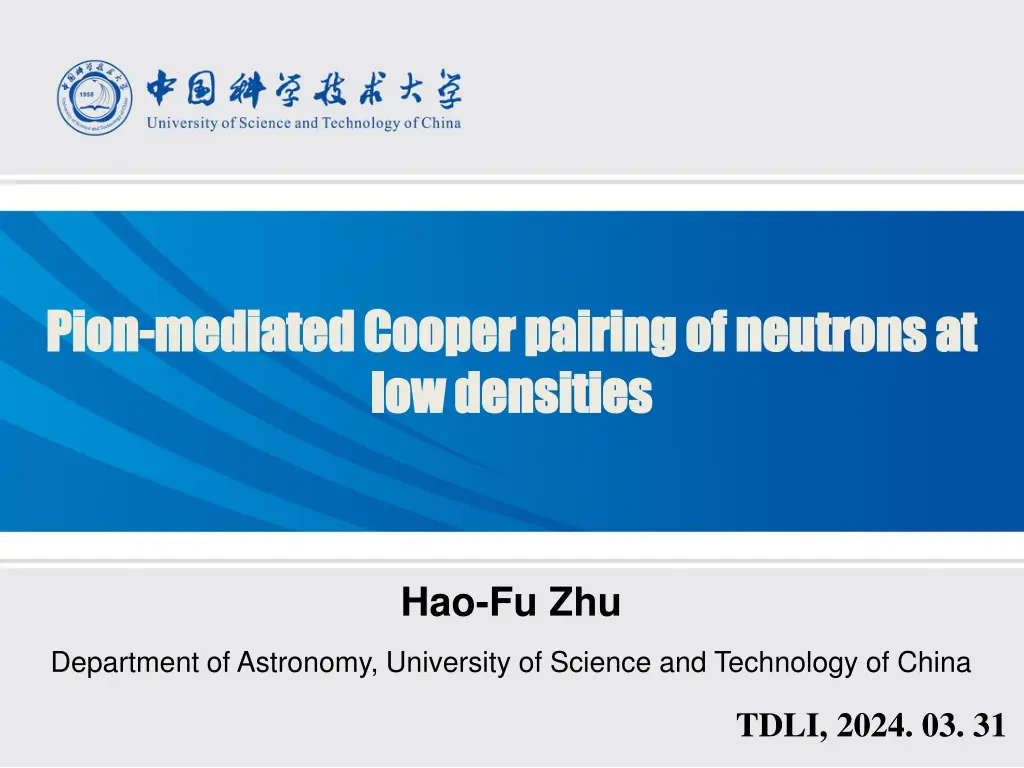
Neutron Cooper Pairing and BCS Theory Limitations
Explore the fascinating world of neutron Cooper pairing at low densities, challenged by the limitations of the BCS theory, and the introduction of the Dyson-Schwinger equation to enhance understanding beyond mean-field approximations.
Download Presentation

Please find below an Image/Link to download the presentation.
The content on the website is provided AS IS for your information and personal use only. It may not be sold, licensed, or shared on other websites without obtaining consent from the author. If you encounter any issues during the download, it is possible that the publisher has removed the file from their server.
You are allowed to download the files provided on this website for personal or commercial use, subject to the condition that they are used lawfully. All files are the property of their respective owners.
The content on the website is provided AS IS for your information and personal use only. It may not be sold, licensed, or shared on other websites without obtaining consent from the author.
E N D
Presentation Transcript
Pion Pion- -mediated Cooper pairing of neutrons at mediated Cooper pairing of neutrons at low densities low densities Hao-Fu Zhu Department of Astronomy, University of Science and Technology of China TDLI, 2024. 03. 31 2025/6/14 1
Lombardo & SchulzearXiv:astro-ph/0012209: BCS gap eqution 2025/6/14 3
BCS theory has made great achievements, but the mean field approximation has limitations! 1. It simplifies the contribution of boson to the interaction V, which is too rough. 2. It ignores the important quantum many-body correlations, including the retardation effects of boson propagation, Landau damping caused by fermion-boson coupling and fermion mass renormalization. 3 3.The BCS theory lacks predictive 2025/6/14 power !!! 4
Introducing the Dyson-Schwinger equation with the example of the electron-phonon coupling model c ( ) Y. Nambu, Phys. Rev. (1960) = p c p p electron propagatorphonon propagator electron free propagator mass renormalization superconducting gap Landau damping 2025/6/14 5
Strict Dyson-Schwinger equation satisfied by the electronic propagator ( ) ( ) q G p G p ig G p 0 = + 1 1 ( ) ( ) q F q ( , ) q p 3 v is the electron- phonon vertex function, which consists of infinitely many Feynman diagrams 2025/6/14 6
Migdal theorem: in common metal, the correction of electron-phonon vertex is very small and can be ignored completely. A. Migdal, JETP (1958): common metal bare vertex = + 1 1 2 G ( ) p G ( ) p ig G p ( q F q ) ( ) 0 3 0 3 q Under the bare vertex approximation, the Dyson-Schwinger equation is called the Migdal-Eliashberg (ME) equation. Now we have a self-closed integral equation that can be solved completely, and it can well explain the isotope 2025/6/14 effect which can not be explained by BCS mean field theory. 7
Hao-Fu Zhu & Guo-Zhu Liu, JPG (2023) 0 Neutron and neutral pion interaction Non-relativistic model : 0N = p p T [ n , n , n , n ] Nambu spinor of neutron operator n p p Rewrite the above Lagrangian density into 2025/6/14 8
Hao-Fu Zhu & Guo-Zhu Liu, JPG (2023) the contribution of the lowest-order vertex correction of neutron-pion can not be ignored. With the increase of neutron density, we can approximately use to replace Migdal theorem fails! + 1 0 . 2025/6/14 9 0
Hao-Fu Zhu & Guo-Zhu Liu, JPG (2023) Improved ME equations = + C G p q F q C + 1 1 2 G ( ) p G ( ) p i ( ) ( ) ( ) 0 1 0 1 0 1 q = x + y + z C q q q 1 0 1 3 2 0 3 2025/6/14 10
Hao-Fu Zhu & Guo-Zhu Liu, JPG (2023) Phase diagram 2025/6/14 11
Only by considering as many possible quantum many-body effects as possible, can we safely extend the theory to a higher density Thank you! 2025/6/14 12 12
